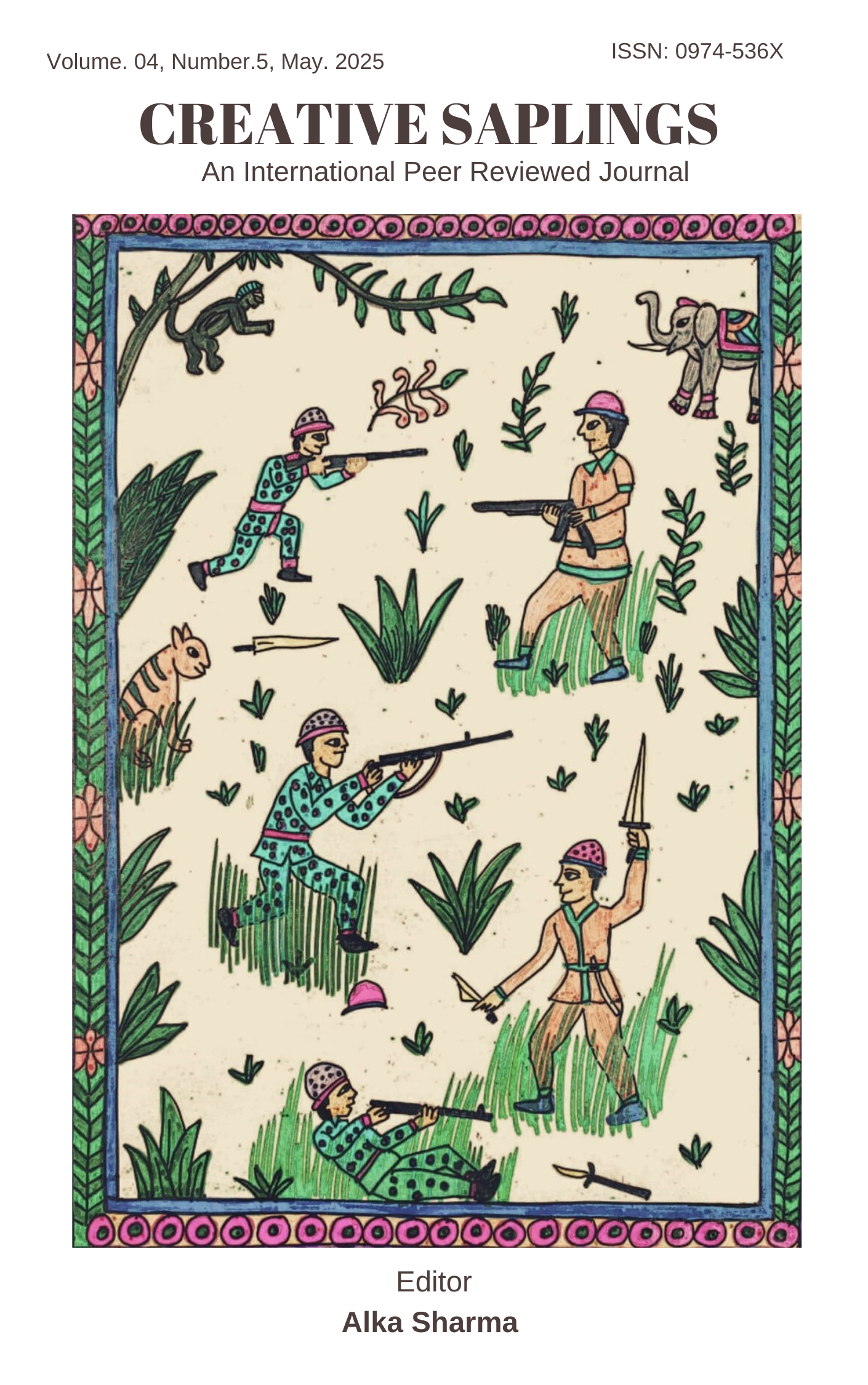Exploring Dialogue-based Writing Task for Developing English Communication in India
DOI:
https://doi.org/10.56062//gtrs.2025.4.05.963Keywords:
Dialogue-based Writing, Task-based Learning (TBL), Pedagogical Strategies, English Communication, Language Learning, Competence Building.Abstract
Indian learners at all levels of education, from school to university, encounter serious obstacles in effective communication in classroom and real-life situations. The primary obstacle to their English communication is the lack of competence in constructing effective dialogues. For most of the learners, such an obstacle occurs due to the lack of a supportive environment, the dearth of English-speaking friends and the dominance of their native language. The study presents the potentiality of dialogue-based writing task as a solution to improve English communication of such learners and examines whether dialogue-based writing task, in which characters in a story communicate with each other directly, helps the learners overcome the gap in their personal and professional development. Accordingly, two sample tasks on dialogue-based writing are given in the paper expecting the learners to generate their own dialogues on different themes, thus stirring them to practice and polish their English communication. Moreover, the paper promotes dialogue-based writing task as an effective pedagogy, which supports the curriculum and assists the learners in gaining higher communicative competence in English. By emphasizing this type of active participation, the study also emphasizes the significance of task-based learning (TBL) in the development of communication skills, which brings about overall educational goals of language learning in India.
Downloads
References
Andrews, P. E. et al. “Talking on Paper: Dialogue as a Writing Task for Sixth Graders.” The Journal of Experimental Education, vol. 58, no. 2, 1990, pp. 87–94. https://doij.org/10.1080/00220973.1990.10806526.
Beattie, Anna. “Exploring the Value of Dialogue in Improving Boys’ Writing.” Changing English, vol. 14, no. 2, 2007, pp. 161–174. https://doij.org/10.1080/13586840701442976.
Cassell, Justine et al. “Animated conversation: rule-based generation of facial expression, gesture & spoken intonation for multiple conversational agents.” Proceedings of the 21st Annual Conference on Computer Graphics and Interactive Techniques, SIGGRAPH 94, Orlando, Florida, July 24-29, 1994, pp.1-8.
Chauhan1, A. S. Functional English. Bhavdiya Prakashan, 2012.
Chauhan2, A. S. Functional Skills in Language and Literature. Bhavdiya Prakashan, 2007.
Chopra, Kamal Nain. “Characterization Techniques for Optical Thin Films.” Optoelectronic Gyroscopes: Design and Applications: 11 (Progress in Optical Science and Photonics), Springer, 2021, pp. 103-130. https://doi.org/10.1007/978-981-15-8380-3_6
Duncan, Starkey. “On the Structure of Speaker–Auditor Interaction during Speaking Turns.” Language in Society, vol. 3, no. 2, 1974, pp. 161–180.
Foroutan, Maryam et al. “How can Dialogue Journal Writing improve learners’ writing performance in the English as a Second Language context?” Journal of Humanities and Social Science, vol. 7, no. 2, 2013, pp. 35-42
Francis-Auton, Emilie et al. “Real Talk: A Realist Dialogic Approach in a Realist Evaluation.” International Journal of Qualitative Methods, vol. 21, 2022, pp. 1-11.
Ginting, Fiber Yun. “An Analysis of Students’ Ability in Using Punctuation Marks in Descriptive Paragraph Writing.” Budapest International Research and Critics Institute-Journal (BIRCI-Journal), vol. 1, no. 3, 2018, pp. 82-88.
Greenaway, K. H. et al. “Shared Identity Is Key to Effective Communication.” Personality and Social Psychology Bulletin, vol. 41, no. 2, 2014, pp. 171-182. https://doi.org/10.1177/0146167214559709
Hegarty, Edward J. How to Write A Speech. Kessinger Publishing, 2007.
Jaipal, Kamini. “English Second Language Students in a Grade 11 Biology Class: Relationships between Language and Learning.” The Annual Meeting of the American Educational Research Association, Seattle, WA, April 10-14, 2001, pp. 1-14.
Koneru, Aruna. Professional Communication. McGraw Hill Education Pvt. Ltd., 2016.
Leech, David H. “Teaching and Learning Vocabulary by I.S.P. Nation.” Teaching and Learning Vocabulary. Issues in Applied Linguistics, vol. 2, no. 1, 1991, pp. 112-116. https://doi.org/10.5070/L421005136
Little, Laura E. “Characterization and Legal Discourse.” Journal of Legal Education, vol. 46, no. 3, 2008, pp. 372-406.
Mashhura, Yakubova. “Strategies for Enhancing Communication Skills in Language Learners.” International Journal of Pedagogics, vol. 04, no. 11, 2024, pp. 47-50. https://doi.org/10.37547/ijp/volume04issue11-08
Om and Som. “The Ultra-soft Power of Bharat: Moving Towards Global Harmony.” International Journal of Law Management & Humanities, vol. 7, no. 6, 2024, pp. 1258-1270. https://doij.org/10.10000/IJLMH.118630
Peyton, Joy Kreeft. “The Influence of Writing Task on ESL Students' Written Production.” Research in The Teaching of English, vol. 24, no. 2, 1990, pp. 142-171.
Purdy, David. “Writing is Work.” Practice Periodical on Structural Design and Construction, vol. 1, no. 2, 1996, pp. 82-84. https://doi.org/10.1061/(ASCE)1084-0680(1996)1:2(82)
Raman, Meenakshi and Sangeeta Sharma. Technical Communication: Principles and Practice. Oxford University Press, 2009.
Riemer, Marc J. “English and communication skills for the global engineer.” Australasian Journal of Engineering Education, vol. 6, no. 1, 2002, pp. 91-100.
Santos, Henrique Laurino Dos and Jonah A. Berger. “The speed of stories: Semantic progression and narrative success.” Journal of Experimental Psychology: General, vol. 151, no. 8, 2022, pp. 1833–1842. https://doi.org/10.1037/xge0001171
Singh, A. “Paragraph Writing– A Stylistic Process.” Researcher, vol. 4, no. 5, 2012, pp. 29-31.
Tshivhase, Mpho. “On the Possibility of Authentic Self-Expression.” Communication, vol. 41, no. 3, 2015, 374–87. https://doi.org/10.1080/02500167.2015.1093329.
Wren, P.C. and H. Martin. High School English Grammar and Composition. Revised by N.D.V. Prasada Rao. S. Chand & Company Ltd., 2008.
Downloads
Published
Issue
Section
License

This work is licensed under a Creative Commons Attribution-NonCommercial 4.0 International License.





